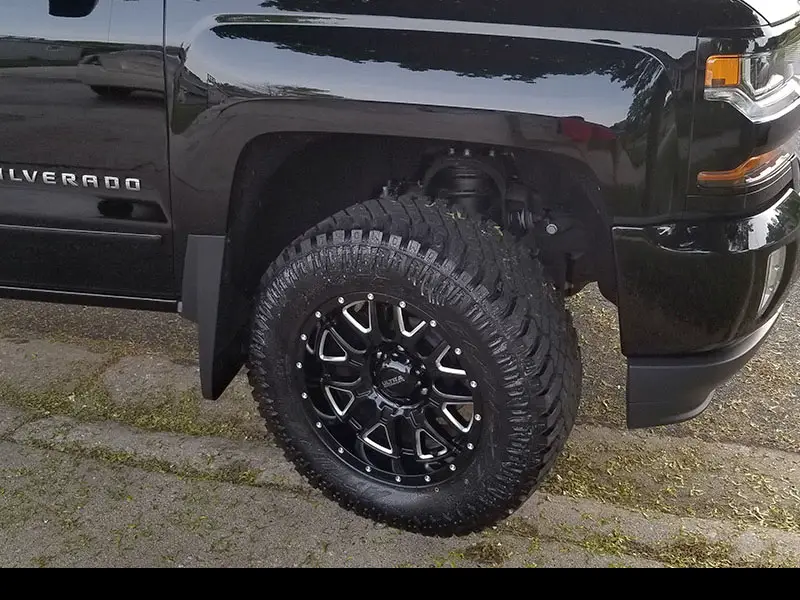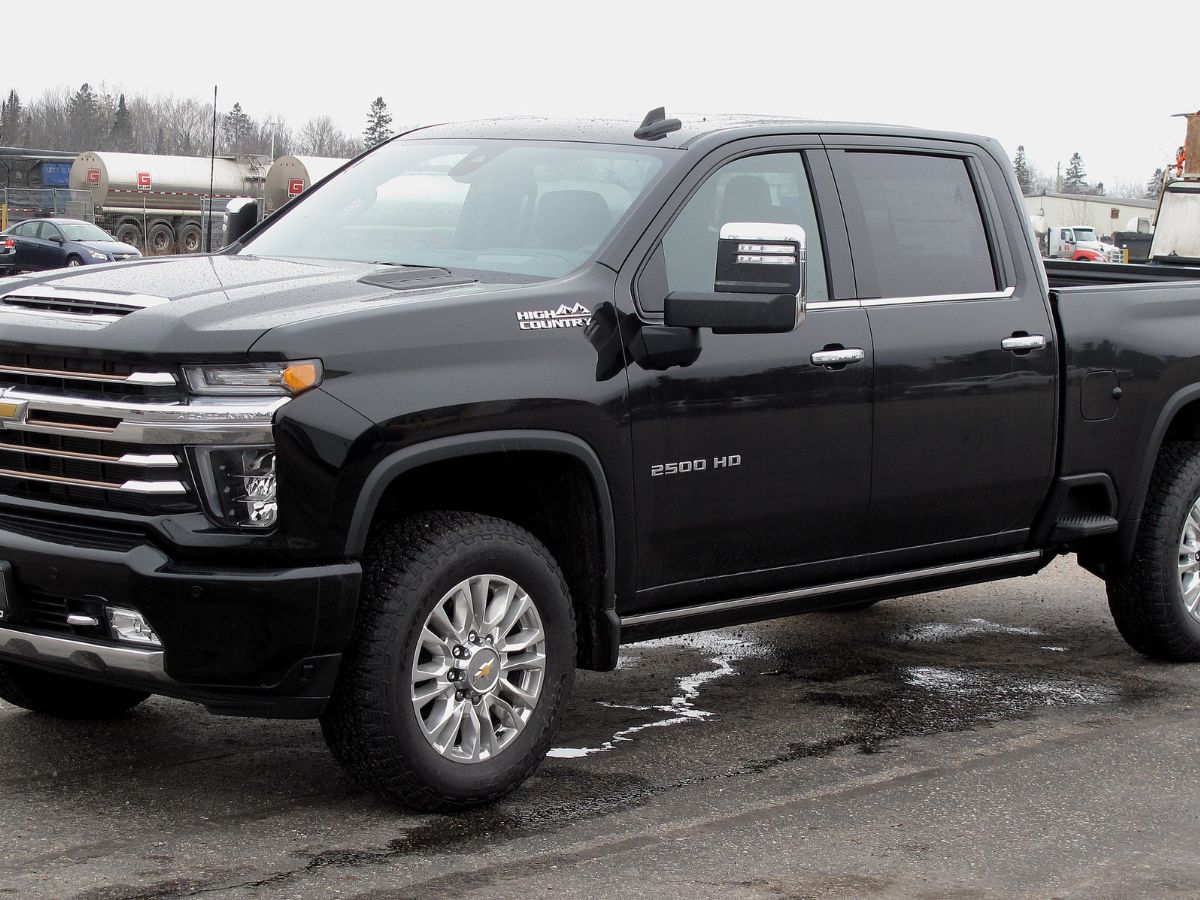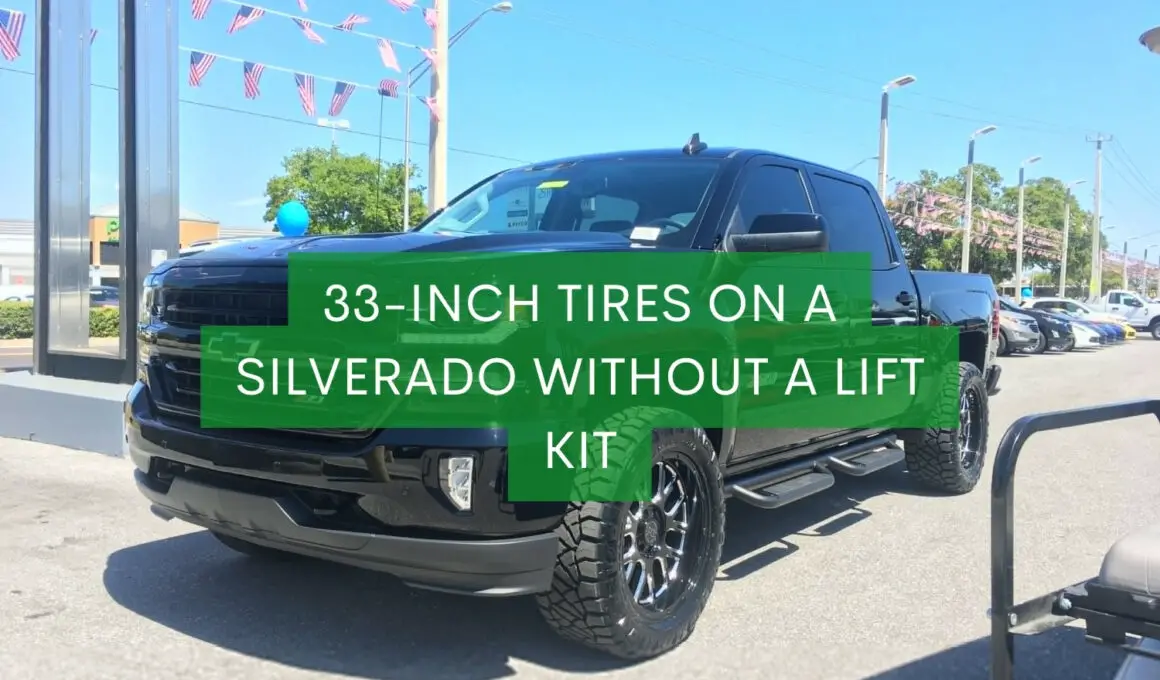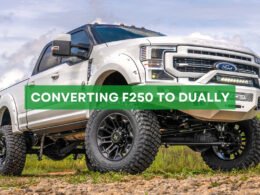In This Article Show
One of the most frequently discussed topics among truck enthusiasts is tire upgrades, particularly on models known for their off-roading capabilities – such as the robust and versatile Silverado.
Truck tires are not a one-size-fits-all affair. The tire size can dramatically impact your vehicle’s performance, handling, and overall off-roading experience.
Many Silverado owners have asked me if it’s possible to fit their trucks with larger, 33-inch tires without resorting to a lift kit. That’s why I’ve decided to put my experience to paper and provide you with a comprehensive guide on this very subject.
In this blog post, we’ll discuss the nuances of wheel specifications, the benefits and potential issues of fitting 33-inch tires, and, most importantly, guide you through fitting these larger tires on your Silverado without a lift kit.
Understanding Wheel Specifications
Before we delve into fitting your Silverado with 33-inch tires without a lift kit, we must understand the basics of wheel specifications. Wheel specifications, including wheel diameter, width, and offset, play a significant role in how your vehicle performs and how well new tires will fit.
1. Wheel Diameter
The wheel diameter is the size of the wheel measured across the middle from one end to the other. It’s important because it affects the tire sizes that can be fitted. In the case of Silverado trucks, standard wheel diameters usually range from 17 to 22 inches.
2. Wheel Width
Wheel width is the distance between the flanges of the wheel, often referred to as the rims. The width of the wheel can impact the width of the tire you’re able to install. Silverado wheel widths typically range from 7.5 to 9 inches. A wider tire may require a wider wheel, which is something to keep in mind when considering 33-inch tires.
3. Wheel Offset
Wheel offset refers to the position of the wheel’s mounting surface in relation to the wheel’s centerline. It plays a crucial role in how the tires sit under your fenders and can impact things like suspension clearance and the overall handling of your vehicle. It can be positive, negative, or zero, and each has implications for how your tires fit and perform.
4. Understanding Clearance
Clearance refers to the space between your vehicle’s wheel well (the space inside the fender where the tire sits) and the tire itself.
Ensuring sufficient clearance is essential when fitting larger tires to prevent rubbing against the wheel well when driving or turning. This is the primary concern when considering fitting 33-inch tires without a lift kit, which we will delve into more deeply in later sections.
Understanding these components and their specifications will help you make informed decisions about modifications and ensure that those modifications align with your truck’s capabilities.

The Basics of 33-Inch Tires
33-inch tires are a popular choice among truck and SUV owners, particularly those keen on off-roading and looking to add both aesthetic appeal and functionality to their vehicle.
As someone who’s been in the industry for over 15 years, I’ve seen the positive impact of a 33-inch tire upgrade on many Silverados. Let’s dive into why they’re a common choice and what you might face when considering this tire size.
Characteristics of 33-Inch Tires
A 33-inch tire refers to the diameter of the tire. This size is typically used on trucks, larger SUVs, and off-road vehicles because they offer a larger contact patch with the ground, which improves traction—particularly useful for off-roading conditions.
33-inch tires also lift the vehicle higher off the ground, providing improved ground clearance. This is beneficial for tackling rough terrains, where you might encounter obstacles like rocks and logs.
Benefits of 33-Inch Tires
33-inch tires offer several advantages:
- Improved Ground Clearance: As mentioned earlier, larger tires elevate the vehicle’s body, allowing for better clearance when traversing off-road obstacles.
- Enhanced Traction: The larger surface area improves grip and stability, especially on uneven or slippery surfaces.
- Aesthetic Appeal: Bigger tires often enhance the rugged and aggressive look of your truck, augmenting its aesthetic appeal.
Common Issues with Fitting Larger Tires
Despite their benefits, fitting larger tires like the 33-inch ones comes with potential issues. The primary concern is the tire rubbing against the wheel well or other components when the vehicle is moving or turning.
The second issue can be a change in your vehicle’s handling. Larger tires can affect the overall drive of your vehicle, sometimes making steering harder. This can be remedied to an extent by properly adjusting your vehicle’s alignment and suspension.
Lastly, bigger tires could impact your vehicle’s fuel efficiency. The increased rolling resistance of larger tires means your engine will need to work harder, which can lead to increased fuel consumption.
Understanding these characteristics, benefits, and potential issues is a crucial step in deciding whether 33-inch tires are a suitable choice for your Silverado.
Why a Lift Kit is Usually Recommended for 33-Inch Tires
When you bring up the topic of larger tires in the auto world, it’s almost inevitable that lift kits will also be part of the conversation. For over a decade and a half in the industry, I’ve seen how lift kits are almost synonymous with larger tires. But why is that the case? Let’s delve into it.
The Purpose and Advantages of Using a Lift Kit
A lift kit is a set of components designed to raise your vehicle’s ride height, typically to accommodate larger tires and increase ground clearance. The process involves modifying the suspension system and adding spacers over the shocks/struts, or adding longer shock absorbers.
Advantages of a lift kit include:
- Increased Clearance: Lift kits raise the body or suspension of your vehicle, providing more clearance for off-roading.
- Extra Room for Larger Tires: By lifting the vehicle, you create more space in the wheel well, allowing for larger tires without the risk of rubbing against the body or suspension components.
- Improved Off-road Performance: The combination of more ground clearance and larger tires often results in better off-road handling and capability.
Situations Where a Lift Kit Might be Necessary
Typically, when upgrading to significantly larger tires, like going from a standard 31-inch to a 33-inch tire, a lift kit is recommended to ensure adequate clearance. Without it, there might be issues of rubbing against the wheel well or suspension components, especially during full turn or when navigating bumps and dips.
However, lift kits aren’t without their challenges. They can be expensive and require professional installation. Additionally, a lift kit can change the vehicle’s center of gravity, which might affect handling and fuel efficiency.
It’s also worth noting that in some regions, excessively lifting a vehicle may not comply with local vehicle regulations.
But the question remains: Can you fit 33-inch tires on a Silverado without resorting to a lift kit? The answer is not a straightforward “yes” or “no”, as it depends on various factors, including the specific model of your Silverado, the wheel specifications, and even the brand and design of the tires.
Can You Fit 33-Inch Tires on a Silverado Without a Lift?
The answer to whether you can fit 33-inch tires on your Silverado without a lift kit is: Yes, it’s possible, but it depends on a few factors. Let’s explore these factors.
Specific Model of Your Silverado
Different Silverado models have different wheel well sizes and suspension setups. For example, a Silverado 1500 can typically accommodate 33-inch tires without a lift kit, while for other models, slight modifications might be necessary to avoid rubbing.
Wheel Offset and Width
As we discussed earlier, wheel offset and width can significantly impact how well a larger tire fits. A wheel with a negative offset or increased width can provide more clearance for the tire, reducing the likelihood of rubbing.
Tire Brand and Design
Not all 33-inch tires are exactly the same size. The actual size can vary slightly between brands and even between different tire models of the same brand. Additionally, the tire’s tread design can impact whether or not it fits without rubbing. More aggressive treads might cause more issues with rubbing.
Real-World Experiences
Many Silverado owners have successfully fitted 33-inch tires without a lift kit, but some reported slight rubbing when the steering wheel was fully turned or when driving over large bumps. Some owners resolved this issue by trimming the wheel well liner or adjusting the wheel offset.
The key takeaway here is that while it’s possible to fit 33-inch tires on a Silverado without a lift, it’s not guaranteed without potential modifications or adjustments. It also involves accepting a certain level of risk for tire rubbing under certain conditions.
Keep in mind that my guidance is grounded in years of professional experience. While this endeavor is feasible, it’s essential to consider the potential risks and trade-offs involved. Safety and longevity of your vehicle should always come first.
Potential Issues of Fitting 33-Inch Tires Without a Lift
As we explore the possibility of fitting 33-inch tires on your Silverado without a lift kit, it’s crucial to understand the potential issues you might encounter. In my 15 years of automotive experience, I’ve found that being aware of potential problems is key to preventing them.
Possible Rubbing Issues and Wheel Well Clearance
The most common issue when fitting larger tires is rubbing against the wheel well, particularly when the steering wheel is at full lock or when going over bumps. This could result in damage to the tire and wheel well lining over time.
Effect on Vehicle Performance and Safety
Larger tires can affect the handling and performance of your vehicle. For instance, your vehicle may feel less responsive to steering input due to the wider tires. Also, larger tires can sometimes lead to an increase in stopping distance. It’s important to adjust your driving style and expect a change in your vehicle’s handling.
Long-term Impact on Vehicle Components
Larger tires are heavier and create more strain on your vehicle’s suspension components, potentially leading to faster wear and tear. Also, bigger tires can alter the gear ratio, affecting the accuracy of your speedometer and potentially increasing fuel consumption.
Even though these issues sound daunting, most of them can be addressed with careful planning and consideration. It’s important to remember that any modification to a vehicle comes with a set of challenges.
Step-by-Step Guide to Fitting 33-Inch Tires on a Silverado Without a Lift Kit
Fitting 33-inch tires on your Silverado without a lift kit is possible but requires careful planning and consideration of potential challenges. In this section, drawing from my 15 years of experience in the automotive industry, I will guide you through the process step-by-step.
Step 1: Choose the Right Tires
Not all 33-inch tires are created equal. They may vary slightly in actual size and design depending on the brand and model. Select a tire that is not only suitable for your driving needs, but also designed in a way that minimizes the chances of rubbing.
Step 2: Choose Suitable Wheels
Consider wheel width and offset when selecting wheels to accompany your new tires. A negative offset wheel can provide more clearance between the tire and the suspension components, reducing the chance of rubbing.
Step 3: Test Fit the Tires
Before fully mounting the new tires, do a test fit. This will allow you to check for any obvious clearance issues without causing any potential damage to the new tires or your vehicle.
Step 4: Check for Rubbing
Once the tires are mounted, perform a full-lock turn test. Turn the steering wheel to full lock in both directions and check for any rubbing issues. Also, test your vehicle over bumps or uneven surfaces to ensure there are no clearance issues.
Step 5: Address Rubbing Issues
If there’s minor rubbing, you may be able to fix it by trimming the inner fender liner or installing wheel spacers. Be aware, however, that both these solutions can have their own set of challenges and potential risks. Always consult with a professional before proceeding with these modifications.
Step 6: Real-world Testing
After addressing any initial issues, it’s time for some real-world testing. Start with light driving and gradually move to more typical driving conditions. Monitor closely for any rubbing or handling issues.
Step 7: Regular Inspection and Maintenance
Regularly inspect your tires and related components, especially after driving off-road or over harsh terrain. This will help you catch any possible issues early and maintain the performance and safety of your vehicle.
Remember, fitting 33-inch tires without a lift kit may pose some risks and challenges, and may not be suitable for all drivers or Silverados. Always prioritize safety and the longevity of your vehicle when considering this modification.
It might be worth consulting with a professional or experienced mechanic to get personalized advice for your specific situation.

6 Tips and Tricks for Fitting 33-Inch Tires on a Silverado Without a Lift Kit
Having successfully navigated the steps involved in fitting 33-inch tires on your Silverado without a lift kit, let’s look at some tips and tricks to ensure the process goes smoothly. My 15 years of experience in the automotive industry have taught me that it’s often these little nuggets of wisdom that make all the difference.
1. Consult with Professionals
While it’s possible to do this upgrade yourself, getting professional advice can be incredibly beneficial. They can provide insights into the specific needs of your Silverado model and give guidance based on previous similar modifications.
2. Don’t Rush the Process
Patience is crucial. Ensure that you take the time to accurately measure, select the right components, and carefully install and test your new tires.
3. Keep a Close Eye on Your Tires
After installing the 33-inch tires, regularly inspect them for any signs of uneven wear or damage. This will help you catch potential issues early before they become significant problems.
4. Pay Attention to Handling
A change in tire size will likely result in a change in your vehicle’s handling. Pay attention to how your Silverado responds, especially during the first few weeks after the tire swap. You might need to adjust your driving style accordingly.
5. Consider Other Modifications
If you notice that the larger tires are causing too much strain on your vehicle, it might be worth considering other modifications. Adjustments to the suspension system or gearing may help accommodate the larger tires.
6. Be Aware of Legal Requirements
In some regions, there are legal limitations on how much you can alter your vehicle’s factory specifications, including tire size. Make sure your modifications comply with local laws to avoid potential penalties.
Undertaking the process of fitting 33-inch tires on your Silverado without a lift kit requires careful thought and consideration.










